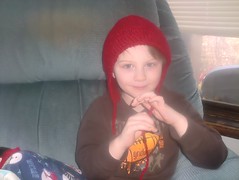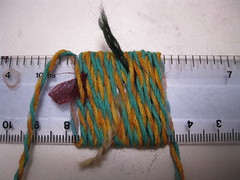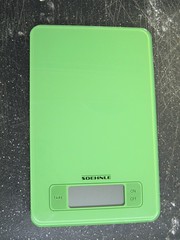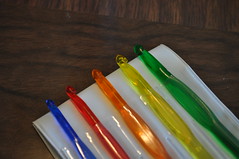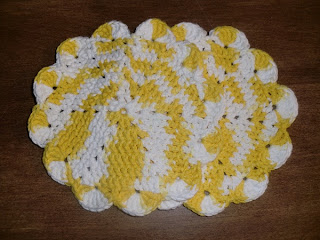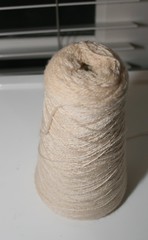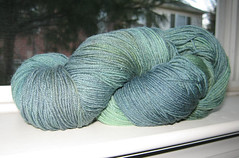I normally try to avoid posting too many plain ads here for yarn that I have for sale, as I really do want this blog to be more about technique, information, and life overall! That being said, I couldn't pass this one up.
Right now I have some extremely luxurious, stunning cashmere silk blend yarn that is on closeout. What we have left is all that we have. This yarn is amazing. It is like working with a cloud. Super soft and a joy to work with, this yarn would be perfect for any special project!
White Cashmere
This yarn also comes in a rich red color as well.
Red Cashmere
At this price, with free shipping, these yarns will *not* last long. So get yours while you can! Treat yourself to a real luxury yarn in sweater quantity!
Thursday, December 29, 2011
Sunday, December 25, 2011
Update!
So I haven't been posting as much as I want to lately. Naughty me! There are a few reasons. One of course is the holidays. On top of a few holiday orders and family gifts to finish up, we have been spending a lot of family time together, which of course comes before internet time! We have had a little bit of snow, so the boys have been having a blast playing around in it.
Beautiful right? I know! So we have been enjoying some quality time outside throwing snowballs and making angels. Plus, like I mentioned in my last post, I am having a bit of a love affair with plarn. It is a bit of work, but what fun! I can't wait to post some of my plarn creations once I finish up with the plarn itself.
Hope that everyone has had a good weekend and a Merry Christmas!
Beautiful right? I know! So we have been enjoying some quality time outside throwing snowballs and making angels. Plus, like I mentioned in my last post, I am having a bit of a love affair with plarn. It is a bit of work, but what fun! I can't wait to post some of my plarn creations once I finish up with the plarn itself.
Hope that everyone has had a good weekend and a Merry Christmas!
Thursday, December 15, 2011
Plarn plarn plarn!
Ok so I was going to work on another post in my crocheting basics series, but instead, thanks to the wonderful generosity of my community, I have been making plarn for 2 days straight! For those who do not know, plarn is plastic yarn :) You take plastic bags of any type, grocery bags, etc, and cut them to create yarn. While I may make my own tutorial for plarn creation in the future, since I am literally up to my eyeballs in plastic bags, I thought I would link to a couple of videos I have found helpful in learning to create this wonderful crocheting and knitting substance out of something that generally ends up in a landfill. The first video is 1-ply plarn and the second video is 2-ply plarn. These are especially useful in making charity projects like sleeping mats for homeless shelters. They hold in heat, keep out vermin, do not rot. I hope you enjoy!
Sunday, December 11, 2011
Crochet Basic Tutorials in Pictures: Slip Knot
People have a variety of ways they learn and some are more effective than others. This tutorial is for those who are primarily photo- and written-oriented.
This is a photo tutorial, along with written instructions, for how to make a slip knot. A slip knot is a knot used when starting any crochet project.

This picture shows the tools that you need to begin crocheting. They are simple: A ball of yarn and a crochet hook. In this tutorial, I am using a ball of light blue yarn and a size K crochet hook. You would use whatever yarn and size hook your project requires.

The first thing that you need to do with the yarn is to make a circle. You can accomplish this easily by wrapping the yarn around your fingers and crossing it over, as illustrated in the picture. In this photo, I left a short tail. For most projects, you will want to leave a longer tail (yarn that is not on the working yarn side of your project) so you will be able to weave in the ends when you are finished. Keep this in mind when creating your slip knot.

Once you have the yarn crossed over your fingers, slip it slightly off your fingers to form a circle of yarn. Take your working yarn and push it through the circle, forming a small loop.

Once you have the small loop formed, pull on the loop to tighten the circle of yarn and form a slip knot, as shown above. This knot is wonderful because if you decide that you have not created a long enough tail or want to start your project over, you can simply pull the tail of the yarn and the knot will unravel.

This is a picture of the crochet hook through the slip knot. The tail is hanging down below and the working yarn is pulled to the left hand side, ready to use!
Stayed tuned for more basic crochet tutorials!
This is a photo tutorial, along with written instructions, for how to make a slip knot. A slip knot is a knot used when starting any crochet project.

This picture shows the tools that you need to begin crocheting. They are simple: A ball of yarn and a crochet hook. In this tutorial, I am using a ball of light blue yarn and a size K crochet hook. You would use whatever yarn and size hook your project requires.

The first thing that you need to do with the yarn is to make a circle. You can accomplish this easily by wrapping the yarn around your fingers and crossing it over, as illustrated in the picture. In this photo, I left a short tail. For most projects, you will want to leave a longer tail (yarn that is not on the working yarn side of your project) so you will be able to weave in the ends when you are finished. Keep this in mind when creating your slip knot.

Once you have the yarn crossed over your fingers, slip it slightly off your fingers to form a circle of yarn. Take your working yarn and push it through the circle, forming a small loop.

Once you have the small loop formed, pull on the loop to tighten the circle of yarn and form a slip knot, as shown above. This knot is wonderful because if you decide that you have not created a long enough tail or want to start your project over, you can simply pull the tail of the yarn and the knot will unravel.

This is a picture of the crochet hook through the slip knot. The tail is hanging down below and the working yarn is pulled to the left hand side, ready to use!
Stayed tuned for more basic crochet tutorials!
Labels:
basics,
beginner,
crochet,
crochet hooks,
information,
overview,
photo,
pictures,
slip knot,
tutorial
Thursday, December 8, 2011
Winter Wonderland!
Busy week here getting ready for company! Decorated the house, did a little bit of crocheting and knitting, and spent a lot of time enjoying the snow!
Tuesday, December 6, 2011
100% cotton crochet wash cloth and towel set, variegated green
Cotton Crochet Wash Cloth and Towel Set
This listing is for a 100% cotton handmade, crocheted wash or dish cloth and towel set. Colored a variegated green, the washcloth measures 8" x 8" and the towel measures 15" x 7.5". They are perfect for everyone in your family, even gentle enough for the little ones in your home. Ideal for bathing, showering, or use them as dish cloths for your kitchen! While they are easy on skin, they are tough on dishes and will not damage Teflon!
This listing is for a 100% cotton handmade, crocheted wash or dish cloth and towel set. Colored a variegated green, the washcloth measures 8" x 8" and the towel measures 15" x 7.5". They are perfect for everyone in your family, even gentle enough for the little ones in your home. Ideal for bathing, showering, or use them as dish cloths for your kitchen! While they are easy on skin, they are tough on dishes and will not damage Teflon!
Labels:
crochet,
Dish Cloth,
Etsy,
For Sale,
Set,
Shop,
Towel,
Wash Cloth
Sunday, December 4, 2011
Fast Update!
New Etsy Shop!
Hello everyone! I just wanted to dash off a quick note to say that I have put my first item in my brand new Etsy shop! I am so excited to explore this venue to share my crafts with everyone. Please stop by, take a look, and let me know any suggestions! It is very very new, so it is a work in progress!
http://www.etsy.com/shop/lareliwcrafts
http://www.etsy.com/shop/lareliwcrafts
Saturday, December 3, 2011
SALE - Mohair Wool Blend Lot of Yarn - Burgundy - 50 gr ball / 8 per pack, Bulky
SALE - Mohair Wool Blend Lot of Yarn - Burgundy - 50 gr ball / 8 per pack, Bulky
This lot consists of 8 skeins of premium fringe yarn, burgundy in color. Each skein contains 50 g (1.76 oz) of yarn equaling 136 yards. Total yardage for 8 skeins is approximately 1088 yards. It is a luxurious yarn which works up quickly and makes beautiful scarves, hats, mittens, and other winter items. Consider buying some for the yarn lover in your life! :)
This lot consists of 8 skeins of premium fringe yarn, burgundy in color. Each skein contains 50 g (1.76 oz) of yarn equaling 136 yards. Total yardage for 8 skeins is approximately 1088 yards. It is a luxurious yarn which works up quickly and makes beautiful scarves, hats, mittens, and other winter items. Consider buying some for the yarn lover in your life! :)
Friday, December 2, 2011
Yarn Basics: No Label, No Problem! How to Determine Weight, Fiber Content, and Yardage of Unlabeled Yarn
Sometimes you will run across yarn in
various formats (skeins, hanks, or loose) that will have no
identifying information about them. This happens fairly often if you
purchase yarn from a garage or estate sale, a thrift store, or are
given someone's old stash. Even though these treasures are unmarked,
there are ways to gather information that can help you determine what
kinds of projects would be appropriate.
First we want to determine the fiber
content of the yarn. While you may not know the specific content
amounts is the yarn is a blend, you can determine the class of fiber
in most cases. To begin with, give the yarn a good feel. Run your
hands over the yarn and take in all the qualities of it. After some
practice, you will become adept at knowing the feel of different base
fibers. Cotton is easiest to detect using feel, as it has a smooth
and cool feel. Acrylic and wool can be trickier, since higher quality
acrylics are soft and fluffy, which cause them to take on a similar
feel to wool blends.
There is a way to tell, however,
whether a yarn is acrylic or wool.
NOTE: PLEASE KEEP OUT OF THE REACH OF CHILDREN. Take a glass jar with a lid on it and write BLEACH / POISON on the side. Put a small amount of bleach in the jar and place a small cutting of the yarn in the bleach. Put it way up high, far from the reach of children, pets, or anyone else. When you check the jar in approximately 12-24 hours, if the yarn has degraded or disappeared, it is wool or wool blend yarn. Wool disintegrates in bleach. If it looks the same after 24 hours, it is acrylic.
Now we have some idea of what our yarn
consists of. Next thing that we need to know is the weight (fingering
or bulky?) and how many yards of yarn we have! The table below lists
the different weights of yarn, the number of yards per pound, and the
number of wraps per inch. Wraps per inch refers to a method of
determining weight using a ruler.
| WEIGHT | YARDS PER POUND | WRAPS PER INCH |
| Zephyr | Over 6000 YPP | Over 45+ WPI |
| Cobweb | Approx. 6000 YPP | Approx. 40+ WPI |
| Lace | 3000-6000 YPP | 36-40 WPI |
| Baby | 2400-3000 YPP | 30-36 WPI |
| Fingering | 1800-2400 YPP | 24-30 WPI |
| Sport | 1300-1800 YPP | 18-24 WPI |
| DK | 1000-1400 YPP | 12-18 WPI |
| Worsted | 900-1100 YPP | 10-12 WPI |
| Aran | 700-1000 YPP | 6-10 WPI |
| Bulky | 400-700 YPP | Approx. 8 WPI |
| Super Bulky (Chunky) | 400 or less YPP | Less than 8 WPI |
So now we have all the numbers we need
to figure out the weight and yardage of our yarn. The first thing to do
is determine how many wraps per inch our mystery yarn is. Take a
ruler and mark off 2 inches on the ruler. Take the yarn and wrap it (not too
loosely or too tightly) around the ruler, making sure that the yarn
does not overlap or leave gaping spaces, but is placed one loop
snugly against another. Continue to wrap the yarn in this manner for
2 inches, count the number of wraps created, and divide by 2. Voila!
That is the number of wraps per inch of the yarn you have. Once you
know the wraps per inch, you can get a good idea of the weight of the
yarn by referencing the chart above.
For example: You take your mystery yarn and do the wraps as per instructions above. Over 2 inches, you have 22 wraps. So you take 22 and divide it by 2 to get 11 wraps per inch. So per the chart above, this mystery yarn is worsted weight.
Next we want to determine the yardage
of the mystery yarn that we have. The easiest and most accurate way
to do this is to weigh an amount of yarn (I use 10 yards) and use
the weight to determine the yards per pound. You want to measure this
accurately so use a kitchen or postage scale if possible, or even a
grocery store produce scale. You can use a bathroom scale, but it is
likely to be inaccurate because it is not sensitive enough.
So take ten yards of yarn and weigh that. Then divide that weight by 10 to get the weight per yard. Then weigh the ball or hank of yarn and divide by the weight per yard. That will give you the approximate yardage. As you can see above, worsted weight yarn is generally between 900 and 1100 yards per pound.
While these steps may not get you the
exact information that would be on a label, it can nevertheless be
very useful in determining the type and size of project appropriate
for those mystery yarn balls!
Labels:
basics,
beginner,
crochet,
fiber,
gauge,
information,
knitting,
label,
materials,
overview,
unlabeled yarn,
yarn
Tuesday, November 29, 2011
Yarn for sale - Wool Blends Glitz Mohair Black Grey Silver Light Pink
Another beautiful yarn offered in my online store! This luxurious Mohair blend makes wonderful scarves, hats, and other gifts. Your imagination is your only limitation! This lovely yarn comes in packs of 8 for only $8.74! Buy one for yourself and one as a gift! Click here to order today!
Sunday, November 27, 2011
One of my favorite yarns - alpaca!
I suggest if you have not knitted or crocheted with Alpaca yarn that you give it a try! Super soft, easy to work with and it has beautiful drape. This particular yarn is a superfine weight (fingering or sock weight) and can be used for a variety of projects, such as baby clothing, blankets, scarves, hats, etc. If you are interested in a different color, fiber, or weight, click the link below and browse my store! We have many different kinds of yarn available! Thank you for looking :)
Incas Alpaca Superfine Blue Lareliw Crafts' Yarn Store
SKU : fnt2-22086Fiber Content : 35% Acrylic, 15% Merino Wool, 50% Alpaca
Needle Size : 2 mm. US 0 [UK 14]
Color : Blue
Main Color : Blue
Brand : ICE
Weight Type : 1 SuperFine: Sock, Fingering, Baby
Length : 600 meters / 656 yds.
Yarn By Type : Luxury, Alpaca
Stock Quantity : 713 (71 Lot)
Weight : 30 gr. / 1.06 oz.
Pictures




Color Options












Quiet on the frontier!
I have been a little quiet on the blogging lately, for a few reasons. Its the holidays, so I have been running around like a nut enjoying the season with my two young boys and husband :) Also I have been doing a lot of organizing of my supplies: yarn, needles, patterns, etc. So I haven't been online and active as much as I would like to be! BUT I will start posting good blog posts again shortly!
Merry Christmas everyone!
Saturday, November 26, 2011
I have begun selling Ice Brand Yarns! They are wonderful, high-quality yarns for very reasonable prices! Please take a look at our website, Ice Yarns and consider making a purchase. These yarns are luxurious and work up quickly and easily into high-quality projects. Love this brand!
Monday, November 21, 2011
Opened a New Online Storefront Today!
Please come and visit us at the Shop Handmade Marketplace! http://www.shophandmade.com/Store/Lareliwcrafts . All the quality kitchen and bathroom cloths and accessories you need, and a whole lot more!
Wednesday, November 16, 2011
Crochet Basics: Crochet Hooks
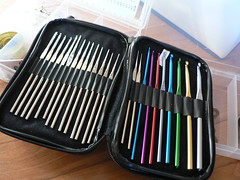
There are several different types of crochet hooks, and they are used for different things. There are steel crochet hooks, aluminum crochet hooks, plastic crochet hooks, and Tunisian or afghan crochet hooks. Steel crochet hooks are the smallest, followed by aluminum and plastic. Tunisian or afghan crochet hooks are unique, as they are long handles with one crochet hook on the end. They resemble a knitting needle more closely than a crochet hook.
Steel Crochet Hooks
Steel crochet hooks are made of steel,
and they are the smallest of crochet hooks. Generally these are used
with crochet thread instead of thicker yarn. They are imprinted on
the side with their size. Some are just steel, while others have
plastic or bamboo handles. Below is a chart of the US sizes with
their millimeter equivalent.
Size 00
|
3.50 mm
|
|---|---|
Size 0
|
3.25 mm
|
Size 1
|
2.75 mm
|
Size 2
|
2.25 mm
|
Size 3
|
2.10 mm
|
Size 4
|
2.00 mm
|
Size 5
|
1.90 mm
|
Size 6
|
1.80 mm
|
Size 7
|
1.65 mm
|
Size 8
|
1.50 mm
|
Size 9
|
1.40 mm
|
Size 10
|
1.30 mm
|
Size 11
|
1.10 mm
|
Size 12
|
1.00 mm
|
Size 13
|
0.85 mm
|
Size 14
|
0.75 mm
|
As you can see from the above chart and
picture, the larger the size number, the smaller the hook size. This
is important to note.
Aluminum Hooks
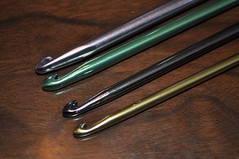
Aluminum hooks are made of aluminum, and they are the larger type of crochet hooks. The sizes that are available in aluminum are also available in plastic and wood. Some companies even offer interchangeable crochet hooks, where the head of the hook can be swapped out to change the size. Like steel hooks, aluminum hooks have their size etched into the side of the hook. Since these are larger hooks than the steel, instead of using thread, these are the hooks you would use with typical yarns. Below is a chart of the aluminum hook sizes.
Size B
|
2.25 mm
|
Size C
|
2.75 mm
|
Size D
|
3.25 mm
|
Size E
|
3.50 mm
|
Size F
|
3.75 mm
|
Size G
|
4.25 mm
|
Size H
|
5.00 mm
|
Size I
|
5.50 mm
|
Size J
|
6.00 mm
|
Size K
|
6.50 mm
|
Size N
|
9.00 mm
|
Three sizes are found only in plastic –
size P, size Q, and size S, which are 10.00 mm, 15.75 mm, and larger respectively.
Tunisian or afghan crochet hooks

Tunisian, afghan, and double pointed
crochet hooks generally come without size markings on the needles,
because the markings would cause the yarn to catch. When you purchase
these needles, the size should be listed on the package of the needle
you purchase. However, if you buy them second-hand or inherit a set
of hooks, you may not know the size or have the original packaging.
There are size gauges available to purchase from most craft stores
that you insert the hook into the various sized holes and you can
figure out which size it is.
Tunisian hooks come in various sizes,
similar to aluminum crochet hooks. The difference is the Tunisian
crochet hook is a long (around 12 inches) hook, which is used much
like a knitting needle. They come in wood, plastic, and metal. The
sizes vary from C through N.
There are other varieties of crochet
hooks out there, especially antique ones, that are unique or
different than those you would find in a store today. Experiment with
any and all sizes and materials, and find which ones you enjoy the
most. Happy hooking!
Tuesday, November 15, 2011
Knitting Basics: Abbreviations!
In order to understand knitting patterns, you must understand the common abbreviations which are used when writing them. Below is a list of common abbreviations encountered in basic patterns along with their meaning. While these will become clear and second nature over time, it may be helpful to print out the list as a reference.

[ ] - Work the instructions within the
brackets as many times as directed.
( ) - Work the instructions within the
parenthesis as many times as directed.
* - Repeat instructions following the *
as directed.
approx - approximately
BO - Bind off
CA – Color A
CB – Color B
CC – Contrasting color
cm – Centimeters
CO – Cast On
cont – Continue
dec – Decrease
DPN – Double pointed needles
fl – Front loop
g – gram
inc – Increase
k – knit
k2tog – knit 2 [stitches] together
m – meter
MC – Main color
mm – millimeters
oz – ounces
p – purl
p2tog – purl 2 [stitches] together
psso – pass slipped stitch over
rep – repeat
rnd – round
RS – Right side
sk – skip
skp – slip, knit, pass over
(decrease)
sk2p – slip, knit 2 together, pass
over (2 decrease)
sl st – slip stitch
ssk – slip, slip, knit these 2
together (decrease)
sssk – slip, slip, slip, knit these 3
together (decrease)
st – stitch
st st – stockinette stitch
tbl – through back loop
tog – together
WS – Wrong side
yd – yard
yo – yarn over
Monday, November 14, 2011
Beautiful rich violet washcloth and scrubby set
Violet Washcloth and Scrubbies Set
This listing is for a 100% cotton handmade, crocheted wash or dish cloth and 2 nubby scrubbies. Colored a rich violet, the washcloth measures 8" x 8" and the scrubbies measure 5" x 4". They are perfect for everyone in your family, even gentle enough for the little ones in your home. Ideal for bathing, showering, or use them as dish cloths for your kitchen! While they are easy on skin, they are tough on dishes and will not damage Teflon!
Treat yourself or friend to handmade wash cloths. They will last for years to come and even with heavy use, the more you use them the softer they get. The scrubbies have a naturally nubby texture which provides gentle exfoliation. Great as a gift for Christmas, stocking stuffer, baby shower, housewarming, wedding gift, or birthday! These beautiful handcrafted cloths will also save you money. They are eco-friendly, durable, and best of all reusable. Just machine wash and dry with your towel load. Some shrinkage may occur, as with all cottons.
These items are ready to ship. All items come from a non-smoking home. Please remember that colors may vary slightly from your computer screen.
This listing is for a 100% cotton handmade, crocheted wash or dish cloth and 2 nubby scrubbies. Colored a rich violet, the washcloth measures 8" x 8" and the scrubbies measure 5" x 4". They are perfect for everyone in your family, even gentle enough for the little ones in your home. Ideal for bathing, showering, or use them as dish cloths for your kitchen! While they are easy on skin, they are tough on dishes and will not damage Teflon!
Treat yourself or friend to handmade wash cloths. They will last for years to come and even with heavy use, the more you use them the softer they get. The scrubbies have a naturally nubby texture which provides gentle exfoliation. Great as a gift for Christmas, stocking stuffer, baby shower, housewarming, wedding gift, or birthday! These beautiful handcrafted cloths will also save you money. They are eco-friendly, durable, and best of all reusable. Just machine wash and dry with your towel load. Some shrinkage may occur, as with all cottons.
These items are ready to ship. All items come from a non-smoking home. Please remember that colors may vary slightly from your computer screen.
New Listing On Ebay
Please see our new listing on Ebay. While it is a crocheted item, we do accept custom orders for both knitting and crocheting! More blog tutorials coming shortly!
Ebay
Ebay
Sunday, November 6, 2011
Yarn Basics: Just How DO You Make This A Ball?
When you purchase yarn, it comes in
many forms. Skein, cone, and hank are the most common. The easiest
way to use the yarn you have is to roll it into a ball. This is
generally pretty straightforward, but the best way to unwind the original yarn form depends on which model your yarn comes in.
Skeins are usually center-pulled,
meaning there is a piece of yarn coming from the center of the skein,
which you pull and the yarn should come smoothly from the middle of
the skein. Some people choose to work from the skein without balling
it. The more preferred method, however, is to ball it because
occasionally you will encounter tangling within the skein, and it is
much easier to untangle the yarn while winding a ball than it is
while knitting a project!
Cones are similar to skeins only they
come in the shape of a cone. Because the yarn is wound around the
cone, it is generally safe to use yarn directly off the cone without
much risk of internal tangling. You can always wind it into a ball
though if you prefer!
Hanks are the most difficult yarn form
to ball. They are composed of the yarn strand, which is looped over
and over then twisted into the more stable hank-form. Therefore, you
cannot center-pull a hank or use the yarn directly from the hank as
you can with skeins and cones. Rather, you must unwind the hank,
place the giant loop of yarn over a holder, such as the back of a
chair, the hands of a helper, or a knitting swifter.
Using any of these holders, you will be able to unloop the yarn and
ball it.
Many
people who use knitting swifters also use ball winders.
The swifter is specially made to hold handspun hanks of yarn, and
the ball winder winds the yarn easily without the hassle of
untangling the looped yarn. Both the ball winders and the swifters
are incredibly useful and worth every penny if you are an avid fiber
artist.
Swift:
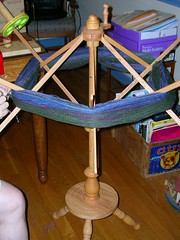
Ball Winder in Action:

Subscribe to:
Posts (Atom)






